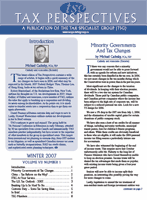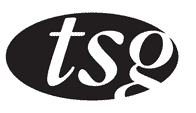
PDF Format
 Issue Contents Issue Contents
 All Issues All Issues
Winter 2007
Volume 7, Number 1
The information in Tax Perspectives is prepared for general interest only. Every effort has been made to ensure that the contents are accurate. However, professional advice should always be obtained before acting and TSG member firms cannot assume any liability for persons who act on the basis of information contained herein without professional advice.
Customs Duty — Some Tax Saving Ideas
Those engaged in international trade view customs duties as a form of "import tax." Unlike other taxes, they represent a deductible expense in the calculation of income earned by the business entity importing goods into Canada. Savings of customs duties fall directly to the bottom line.
Just as in the case of income taxation, there is a considerable amount of strategizing available to importers that, if implemented, can reduce their liabilities for import tax. These strategies relate to tariff classification, origin, and the value for duty of the imported goods. In addition, import tax may be relieved by the use of special programs that either remit, or permit drawback of, the customs duties and, in some cases, goods and services tax (GST). (GST is payable upon importation on the value-for-duty plus the duty payable.)
Tariff Classification
All goods imported into Canada must be classified under a unique tariff number from one of thousands of classification numbers contained in the Customs Tariff. Each unique tariff number stipulates the rate of customs duties payable on goods there described.
Tariff classification of imported goods is an essential component of the analysis and planning and should be conducted by the importer prior to engaging in an international transaction. Some considerations in classifying the goods are as follows: - Materials of which the goods are composed;
- Primary function performed by the goods;
- Means of operation of any mechanical goods;
- Use to which the goods will be put;
- Other goods that will be used in conjunction with, or that will be incorporated in, the goods;
Goods are classified according to their physical characteristics and, occasionally, their usual end-user rather than according to actual end-use, or whether or not they are of a class or kind manufactured in Canada.
While there is no clear-cut rule that establishes a relationship between the degree to which a good is processed and the rate of duty that applies to its classification, it is often the case that goods that are more fully processed carry a higher rate of customs duty.
Accordingly, the degree to which the good is finished may impact on the amount of duty payable. Importers should take this into account when determining their sourcing practices.
Origin
The origin of goods determines, in part, the tariff treatment to be applied. Within a single line of tariff classifications, there are a number of potential rates of duty, depending on the origin of the goods. The tariff treatment may vary as between goods imported from the United States, Chile, Mexico, or Israel, and those from elsewhere. Canada has free trade agreements with these countries and is developing other free trade agreements. The most-favoured-nation tariff treatment applies in respect of goods imported from these countries unless they qualify pursuant to specific rules of origin, which have been promulgated under the free trade agreements. If so, the duties are generally reduced to zero. This assists, in particular, when importing goods that would otherwise carry high rates of duty that, in turn, would make them uncompetitive. Similarly, an importer may choose to source from a "free trade partner" country in order to gain an advantage over other importers who have to pay higher rates of duty.
The rules of origin vary with each tariff classification. Generally, the rules contemplate that goods coming from a qualifying country (e.g., the U.S.) will have originated there or undergone some form of transformation before export to Canada. These rules are rather sophisticated but they provide excellent opportunities for importers to reduce their import tax liability.
Value for Duty
The third component in relation to determining the amount of customs duties payable is the value for duty. In general, the value for duty is based on the price in a sale for export to Canada to a purchaser in Canada. But, in some cases, the sale price cannot be used, in which case an alternative method is applied.
From a planning point of view, it is possible to organize transactions so as to minimize the base upon which a rate of duty will be applied. The base may be structured to segregate portions of the price as between (i) the price paid for the goods, and (ii) amounts payable for non-dutiable elements. Among these non-dutiable elements are certain management fees, royalties, licence fees, transportation costs and insurance of the goods from the place of direct shipment to Canada, and the construction, erection and other services provided in relation to the goods once imported into Canada. The allocation of the price amongst these various components will mitigate the amount of duties payable. This type of planning involves careful consideration of the allocations as well as proper documentation for support, in the event of a customs audit.
Other Forms of Relief
One can reduce or eliminate customs duty on qualifying goods through duties relief incentives.
Under duty deferral programs, importers can defer, or be relieved of, the payment of duties. The Duties Relief Program enables importers to import goods without having to pay duties and taxes (with the exception of GST) when the goods are to be exported or incorporated into the production of goods to be exported. The Drawback Program contemplates that duties will be refunded on imported goods when these goods are exported. Finally, a bonded warehouse is a facility operated by the private sector and regulated by the Canada Border Services Agency. In such a warehouse, the importer may store imported goods without having to pay duties and GST, as long as the goods are not released in Canada.
There are also remissions and temporary importation programs that may permit goods to enter Canada duty-free.
Conclusion
To minimize customs duties and, hence, import taxes, the astute importer will arm itself with various customs duty minimization strategies discussed above as well as others, which may apply, depending on specific circumstances. Savings of customs duties go directly to the profit line and can convert otherwise unprofitable transactions into those which contribute meaningfully to the success of the business entity. The importer must be cognizant that planning must be done within a context of compliance. Accordingly, it is important to obtain experienced advice to assist in import tax planning.
|




